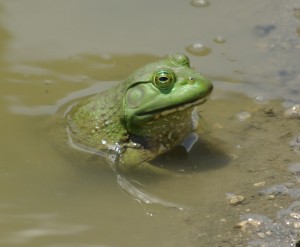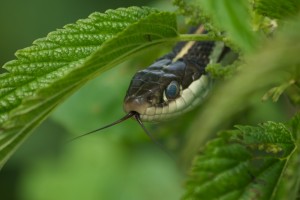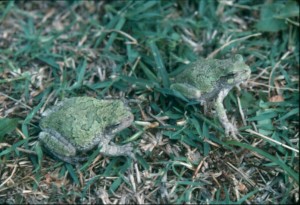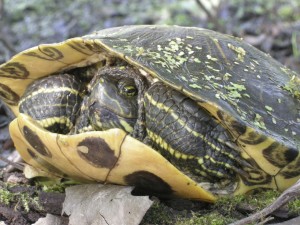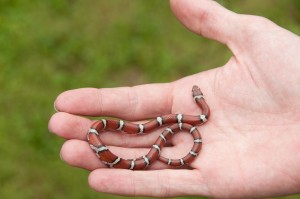Bluff lands home to wonderful variety of amphibians & reptiles
For a lot of people the very
words amphibian and reptile conjure up repulsive images of scaly, slimy, slithering creatures–apparitions of evil and danger. If that’s the case for you, read no further. For other folks, amphibians and reptiles represent a fascinating group of animals–with staring unblinking eyes, fluid movements, remarkable shapes and colors–which hold a pivotal place among the stunning wildlife of our bluff lands.
Collectively, amphibians and reptiles are biologically grouped as “herpetofauna,” or animals that “creep.” Herpetofauna is a hard word to say, so most enthusiasts simply call them “herps.”
Amphibians, a name which comes from Greek words for “two lives,” constitute their own special class, consisting of frogs, toads and salamanders. The distinguishing characteristic of all amphibians is the two distinct stages in their life cycle. Amphibian eggs are laid in water and hatch into aquatic young called larvae. Upon reaching maturity, amphibians leave the water and take up a terrestrial or semi-aquatic existence.
Nearly all amphibians have a very thin and delicate skin that they use for breathing. Their skin is water-permeable and dries out quickly. As a result, almost all amphibians are found close to water or in damp and humid surroundings.
Their dependence upon water is most important during reproduction. The eggs of all amphibians are coated with a jelly-like covering. This gelatinous coating dries out very quickly so most species will only lay their eggs in water or very damp places.
Reptiles belong to a second class of herps and are comprised of turtles, lizards and snakes. Reptile comes from a Latin word, reptilia, meaning “to crawl.” Reptiles are distinguished from amphibians by their scaly skin, which protects them from scratches and abrasions much more effectively than the thin, delicate skin of an amphibian. And the skin of a reptile is waterproof and retains body moisture, freeing reptiles from remaining in damp or wet environments.
Even more important, most reptiles lay amniote eggs. Unlike the naked, exposed eggs of amphibians, the reptile egg is surrounded by a hard protective shell, which protects the developing embryo from drying out and frees reptiles of the necessity of being near water. Unlike amphibians, which have an aquatic water stage, most reptiles hatch from eggs fully developed, a miniature copy of their parents.
Our bluff lands are home to a stupendous variety of herps. Our wetlands, sinkhole ponds, and cavernous karst terrain host a number of interesting and rare amphibians. Nine species of salamanders live here. These include the cute and colorful spotted and marbled salamanders; smallmouth, tiger, and northern slimy salamanders; newts and lesser sirens. In addition, cave and longtail salamanders are particularly fond of our karst terrain.
Seventeen species of frogs and toads call the area home. Cricket frogs, Cope’s gray treefrogs, eastern gray treefrogs, spring peepers, western chorus frogs, plains leopard frogs, bullfrogs, green frogs, northern leopard frogs, pickerel frogs, southern leopard frogs, wood frogs, Strecker’s chorus frogs; and, American toads, Fowler’s toads, narrowmouth toads and spadefoot toads. They collectively serenade our springtime and summertime evenings with full orchestral scores of syncopated call notes, reminding us that they share our bluffs and bottoms homeland.
There are eight species of turtles in the county: spiny softshells, snappers, painted, false map, musk and red-eared sliders hang in and around water. Box and the rarely seen ornate box turtles can thrive in our dry uplands.
Five species of lizards can be found in the county. Six-lined racerunners, five-lined skinks, broadhead skinks, ground skinks, and northern fence lizards love the varied habitats in the hill prairies and deep woods of the bluff corridor.
Twenty-three snake species live in our area: small worm snakes, racers, ringnecks, rare and endangered great plains ratsnakes, black ratsnakes, eastern hognose snakes, prairie kingsnakes, speckled kingsnakes, beautifully colored red milksnakes, exceedingly rare eastern coachwhip snakes, yellowbelly / diamondback / northern water snakes, rough green snakes, Graham’s crayfish snakes, brown snakes, redbelly snakes, endangered flathead snakes, western ribbon snakes, eastern garter snakes, smooth earth snakes, and our venomous copperheads and timber rattlesnakes. Western cottonmouths have not been seen in the county since the Flood of 1993.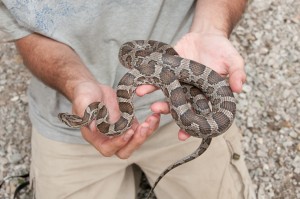
Taken together, our bluff lands corridor is a herps heaven, with every imaginable sized and colored herpetofaunal critter living here — more than almost anywhere else in the state.
Clifftop, a local nonprofit organization, is focused on preserving and protecting area bluff lands.
A version of this article appeared in the 20 April 2012 edition of the Monroe County Independent.
© 2012 all content rights reserved, Clifftop NFP.
Comments are currently closed.

